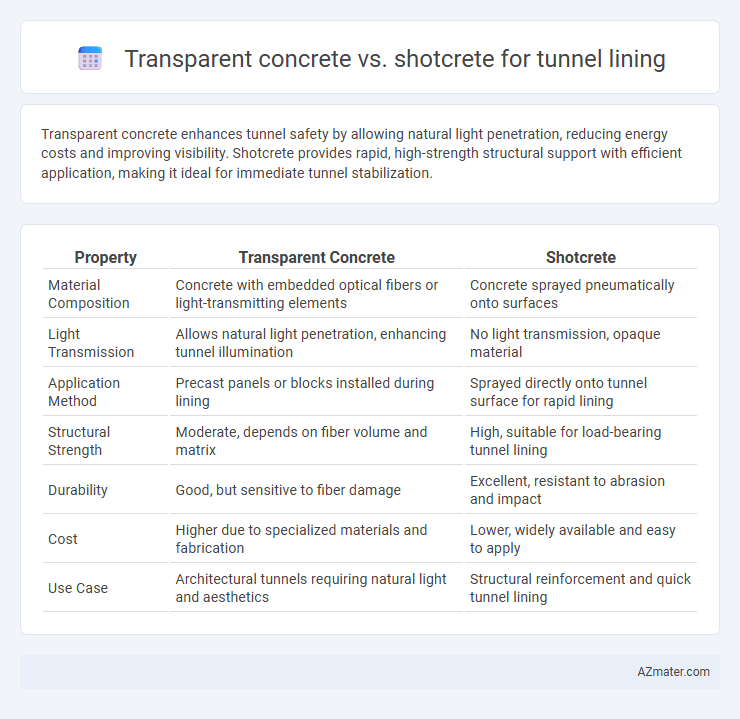Transparent concrete enhances tunnel safety by allowing natural light penetration, reducing energy costs and improving visibility. Shotcrete provides rapid, high-strength structural support with efficient application, making it ideal for immediate tunnel stabilization.
Table of Comparison
| Property | Transparent Concrete | Shotcrete |
|---|---|---|
| Material Composition | Concrete with embedded optical fibers or light-transmitting elements | Concrete sprayed pneumatically onto surfaces |
| Light Transmission | Allows natural light penetration, enhancing tunnel illumination | No light transmission, opaque material |
| Application Method | Precast panels or blocks installed during lining | Sprayed directly onto tunnel surface for rapid lining |
| Structural Strength | Moderate, depends on fiber volume and matrix | High, suitable for load-bearing tunnel lining |
| Durability | Good, but sensitive to fiber damage | Excellent, resistant to abrasion and impact |
| Cost | Higher due to specialized materials and fabrication | Lower, widely available and easy to apply |
| Use Case | Architectural tunnels requiring natural light and aesthetics | Structural reinforcement and quick tunnel lining |
Introduction to Tunnel Lining Materials
Tunnel lining materials play a critical role in ensuring structural integrity and durability under various geological conditions. Transparent concrete integrates optical fibers within conventional concrete, offering enhanced aesthetic appeal and natural light transmission but limited structural reinforcement compared to traditional methods. Shotcrete, a pneumatically applied concrete mixture, provides rapid application, excellent bonding to irregular surfaces, and superior strength, making it a preferred choice for primary and secondary tunnel linings due to its adaptability and structural performance.
What is Transparent Concrete?
Transparent concrete, also known as light-transmitting concrete, incorporates optical fibers or resin-based materials within the cement matrix to allow light to pass through while maintaining structural integrity. This innovative material enhances tunnel lining by improving natural light transmission and visibility, potentially reducing energy costs and increasing safety in underground environments. Compared to shotcrete, which is a quick-setting sprayed concrete primarily valued for rapid application and structural support, transparent concrete offers added aesthetic and functional benefits by enabling light diffusion within the lining.
What is Shotcrete?
Shotcrete is a high-velocity application of concrete or mortar projected through a nozzle onto tunnel walls, providing immediate structural support and effective adherence to complex surfaces. It offers excellent versatility, rapid curing, and durability in tunnel lining applications where traditional formwork is impractical. Compared to transparent concrete, shotcrete excels in reinforcing underground structures with robust, corrosion-resistant layers tailored for varying geological conditions.
Composition and Properties Comparison
Transparent concrete integrates optical fibers embedded in a cement matrix, allowing light transmission without compromising structural integrity, making it suitable for tunnel lining where natural light diffusion is beneficial. Shotcrete consists of a mixture of cement, sand, aggregates, and water, sprayed at high velocity to form a dense, durable lining that provides superior mechanical strength and rapid application for tunnel reinforcement. While transparent concrete offers unique translucency and aesthetic properties, shotcrete excels in structural durability, impact resistance, and cost-effectiveness for tunnel support.
Structural Performance in Tunnel Lining
Transparent concrete offers enhanced structural performance in tunnel lining by combining load-bearing capacity with natural light transmission, reducing the need for artificial lighting and improving safety. Shotcrete delivers high compressive strength and excellent adhesion to irregular surfaces, ensuring rapid application and durability under tunnel lining stresses. While shotcrete excels in structural resilience and adaptability, transparent concrete integrates strength with aesthetic and functional benefits, optimizing tunnel environments.
Light Transmission and Aesthetics
Transparent concrete enhances tunnel lining by allowing natural or artificial light to penetrate, improving visibility and reducing energy costs, while offering a modern aesthetic with translucent surfaces. Shotcrete provides a robust, durable lining with excellent structural support but lacks light transmission capabilities and offers limited aesthetic appeal. In projects prioritizing illumination and visual impact, transparent concrete significantly outperforms shotcrete in combining function and design innovation.
Durability and Maintenance Requirements
Transparent concrete offers moderate durability for tunnel lining but requires careful embedding of optical fibers to prevent damage and maintain its light-transmitting properties over time. Shotcrete provides superior durability with high resistance to abrasion, impact, and chemical attack, making it ideal for harsh tunnel environments. Maintenance for transparent concrete involves regular inspection of fiber integrity, while shotcrete demands routine crack repair and surface treatment to ensure long-term structural performance.
Installation Methods and Construction Speed
Transparent concrete installation in tunnel lining involves embedding optical fibers within the concrete matrix, requiring precise casting and curing processes that extend construction time compared to traditional methods. Shotcrete application employs high-velocity spraying of concrete onto tunnel surfaces, enabling rapid layer buildup and immediate surface adhesion that significantly accelerates construction speed. The shotcrete method's adaptability to complex geometries allows for quicker installation, while transparent concrete's intricate fabrication demands more controlled conditions, impacting overall project timelines.
Cost Analysis: Transparent Concrete vs Shotcrete
Transparent concrete, featuring embedded optical fibers, typically incurs higher material and manufacturing costs than conventional shotcrete used for tunnel lining applications. Shotcrete offers cost-efficiency through rapid application and lower raw material expenses, making it the preferred choice for large-scale infrastructure projects with budget constraints. Despite the premium price of transparent concrete, its potential benefits in natural light transmission and structural monitoring can offset long-term maintenance costs compared to standard shotcrete linings.
Future Trends and Applications in Tunnel Engineering
Transparent concrete offers innovative possibilities for tunnel lining by integrating light transmission while maintaining structural strength, enhancing safety and aesthetic appeal in underground environments. Shotcrete remains a preferred method for rapid, flexible tunnel lining installation, with advancements focusing on fiber reinforcement and accelerated curing techniques to improve durability and reduce construction time. Future tunnel engineering trends are expected to combine transparent concrete's light-enhancing properties with shotcrete's adaptability, promoting energy-efficient lighting systems and robust structural support in complex subterranean projects.

Infographic: Transparent concrete vs Shotcrete for Tunnel lining
 azmater.com
azmater.com